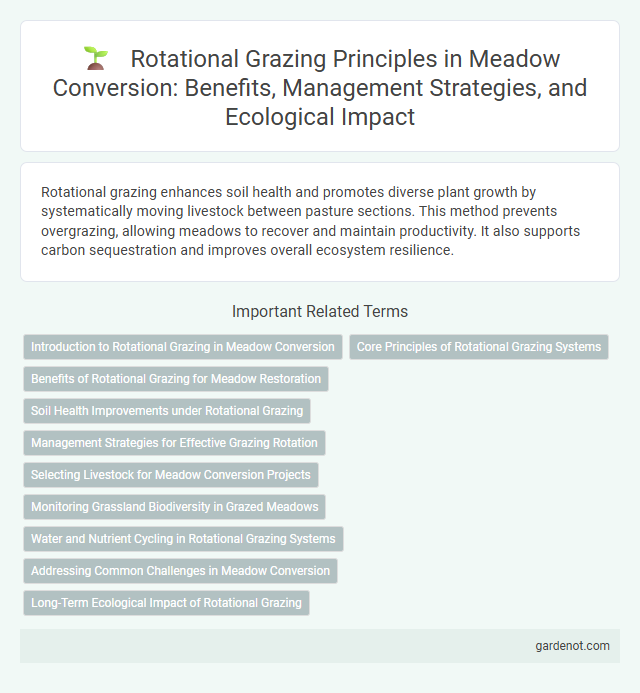Rotational grazing enhances soil health and promotes diverse plant growth by systematically moving livestock between pasture sections. This method prevents overgrazing, allowing meadows to recover and maintain productivity. It also supports carbon sequestration and improves overall ecosystem resilience.
Introduction to Rotational Grazing in Meadow Conversion
Rotational grazing enhances meadow conversion by dividing pasture into multiple paddocks and grazing livestock sequentially, promoting regrowth and improving forage quality. This method increases soil fertility and plant diversity through controlled grazing periods and rest intervals, leading to sustainable pasture management. Implementing rotational grazing results in higher biomass production and reduces soil erosion compared to continuous grazing systems.
Core Principles of Rotational Grazing Systems
Rotational grazing systems optimize pasture health by dividing meadows into multiple paddocks, allowing livestock to graze one section at a time while others recover. Key principles include managing grazing duration, ensuring rest periods for vegetation regrowth, and monitoring forage availability to prevent overgrazing. This approach enhances soil fertility, promotes biodiversity, and improves overall pasture productivity.
Benefits of Rotational Grazing for Meadow Restoration
Rotational grazing enhances meadow restoration by promoting diverse plant growth and improving soil fertility through controlled grazing pressure. This method reduces overgrazing, allowing native grasses and wildflowers to recover, which increases biodiversity and habitat quality. Improved root systems from healthy plants also enhance water infiltration and carbon sequestration, supporting long-term ecosystem resilience.
Soil Health Improvements under Rotational Grazing
Rotational grazing enhances soil health by promoting diverse plant growth and increasing organic matter content, which improves soil structure and water infiltration. The periodic rest periods in grazing prevent overgrazing, allowing root systems to recover and enhance microbial activity vital for nutrient cycling. Enhanced soil aeration and reduced compaction under rotational grazing lead to increased soil fertility and long-term sustainability of meadow ecosystems.
Management Strategies for Effective Grazing Rotation
Rotational grazing optimizes pasture productivity by dividing meadows into multiple paddocks, allowing controlled grazing periods followed by adequate rest for regrowth. Effective grazing rotation management strategies include monitoring forage height to prevent overgrazing, adjusting stocking rates based on seasonal forage availability, and scheduling grazing intervals to enhance soil health and plant biodiversity. Implementing a precise rotation plan increases forage yield, improves animal performance, and supports sustainable pasture ecosystems.
Selecting Livestock for Meadow Conversion Projects
Selecting livestock for meadow conversion projects requires prioritizing species and breeds that enhance soil health, promote diverse plant growth, and optimize forage utilization. Rotational grazing with hardy, adaptable animals like sheep, goats, and mixed-species herds improves nutrient cycling and controls invasive species effectively. Properly matched livestock to meadow ecology increases biomass productivity, supports wildlife habitats, and boosts long-term land resilience.
Monitoring Grassland Biodiversity in Grazed Meadows
Rotational grazing enhances grassland biodiversity by allowing periods of rest and recovery for plant species, promoting diverse vegetation structures in grazed meadows. Rigorous monitoring of species composition, soil health, and insect populations provides essential data to adjust grazing intensity and duration for optimal ecosystem balance. Implementing adaptive management based on biodiversity indicators supports sustainable meadow conversion and preserves habitat quality.
Water and Nutrient Cycling in Rotational Grazing Systems
Rotational grazing enhances water infiltration and retention by allowing pastures to rest, promoting deeper root growth and improved soil structure. This dynamic system facilitates efficient nutrient cycling as livestock manure is distributed evenly, enriching soil fertility and boosting microbial activity. Optimized water and nutrient availability under rotational grazing supports sustainable forage production and ecosystem resilience.
Addressing Common Challenges in Meadow Conversion
Rotational grazing enhances soil health and biodiversity by systematically moving livestock between meadow sections, reducing overgrazing and promoting even nutrient distribution. Implementing proper fencing and water access addresses livestock management challenges, ensuring optimal forage recovery and growth. Monitoring pasture condition and adjusting grazing frequency mitigate weed invasion and soil compaction during meadow conversion.
Long-Term Ecological Impact of Rotational Grazing
Rotational grazing enhances soil health by promoting nutrient cycling and increasing organic matter, which supports sustained plant biodiversity and ecosystem resilience. It reduces overgrazing and soil compaction, mitigating erosion and improving water infiltration rates crucial for meadow conversion. Long-term application of rotational grazing fosters habitat restoration and carbon sequestration, contributing to climate change mitigation and sustainable agricultural landscapes.
Rotational grazing Infographic

 gardenot.com
gardenot.com